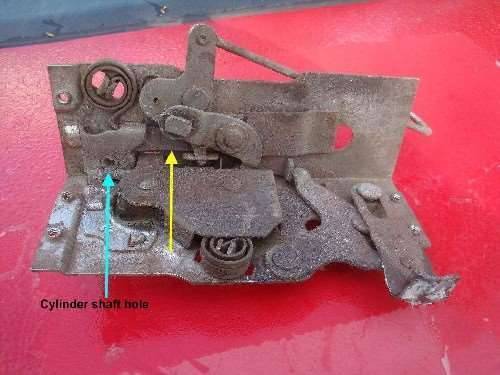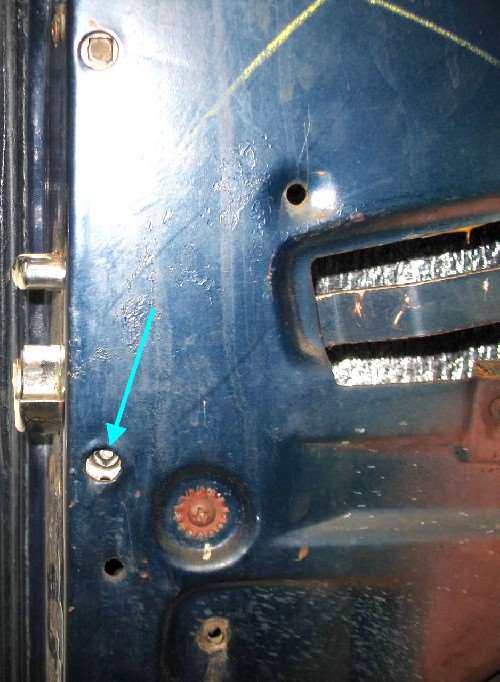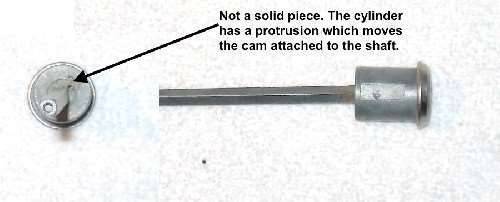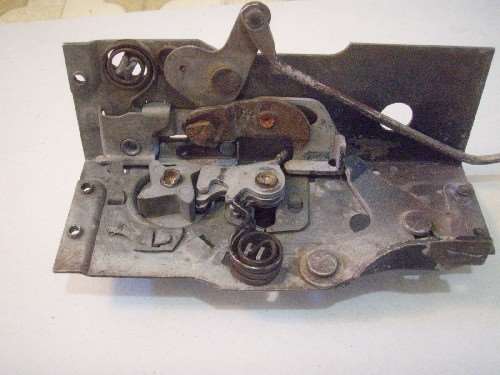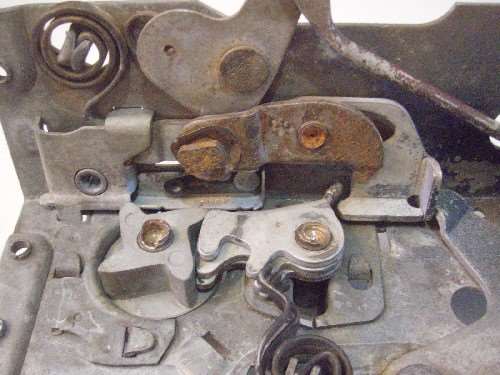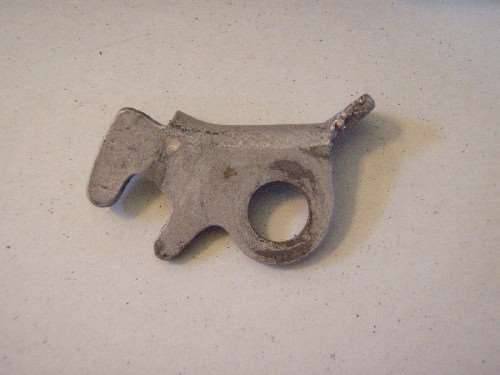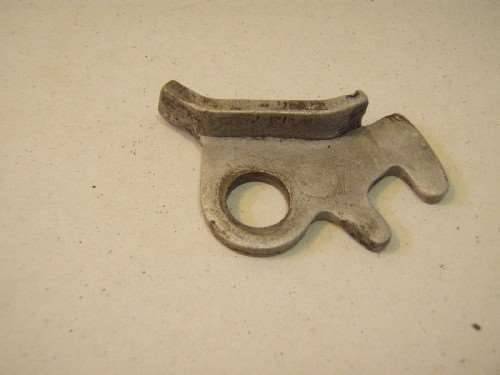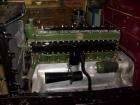|
Re: 1948 door latch
|
||||
|---|---|---|---|---|
|
Home away from home
|
Thank you Howard.
Since the key cylinder does move the button would you say at this point a complete 'tang' failure should be considered a lower probability? Your insight is well taken however; the 'tang' could be worn or slightly bent. Since receiving your message I've tried to rotate the key and push the button simultaneously . . . no difference. That was a combination that was not tried initially. Before I had the cases button only, and key only. Adding the case 'button and key' didn't add additional insight, but should have worked if wear or deflection was the only issue. I went 'on-line' and quickly learned that right side latch assemblies are readily available . . . not so much for the left side. Right now I'm thinking about buying a right side latch to educate myself on the details of the design. There is a chance that the part I need is not a 'mirror image' component. As in the case of the trunk latch are we dealing with another part made by the Swiss company? I too would be reluctant to stab my door panel. From your pictures a long thin needle would be ideal, but as long as the needle was about an inch longer than the lock cylinder is should work. I'm not constrained by the labor hour issue the dealership may have had to contend with, so I would be inclined to remove the door panel. dp
Posted on: 2017/4/2 12:50
|
|||
|
||||
|
Re: 1948 door latch
|
||||
|---|---|---|---|---|
|
Home away from home
|
Here are some photos of the internal parts on a left side 1948 door latch.
The broken piece that you have shown is likely from the small lever that holds and releases the rotating latch wheel as shown in the last 2 photos. Would explain why neither the inside or outside handle will release the latch.
Posted on: 2017/4/4 15:14
|
|||
|
||||
|
Re: 1948 door latch
|
||||
|---|---|---|---|---|
|
Forum Ambassador
|
That broken metal sure looks like it came off that latch release piece. That must have taken incredible force or else the piece is so rusty there was no strength left. Either way the only way I would think the door could be opened to remove the latch without doing some severe damage is to try and approach it from the hinge end.
Posted on: 2017/4/4 16:09
|
|||
|
Howard
|
||||
|
||||
|
Re: 1948 door latch
|
||||
|---|---|---|---|---|
|
Home away from home
|
I've got a short up-date on the difficulty I'm having with locking the driver's side door on my '48.
Just to review, the latch works fine, the outer handle opens the door, the inner handle opens the door, but neither the key nor the button will lock the door. The button will not 'stay down' and will just pop-up every time it is pushed down. Yesterday I removed the key cylinder and connecting shaft . . . that did not change any of the symptoms. The only good news is that I have successfully reinstalled the cylinder lock without removing the door panel, or resorting to the long needle method (aka stabbing the door panel). Before you throw out that old set of windshield blades take a look at them and if they have two pieces of metal (stainless steel) on either side of the rubber wiper element, then rip the mess apart and harvest the pieces of stainless. I used a small 'tie-wrap' to strap this wiper stiffener to the Packard lock shaft and used it to support and guide the shaft into the latch assembly. Once you think the shaft is engaged slowly remove the stiffener . . . there is just enough room . . . the cylinder needs to be slightly pointed upward to remove the stiffener. The 'tie-wrap' is now captured between the latch and cylinder. I must admit it took more than one try and in each case the 'tie-wrap' was still just where it was before I removed the stiffener. If the 'tie-wrap' is tight enough it does not seem to move when the stiffener is removed. Now that I know it is not the cylinder lock my best guess is that the small leaf spring that holds the button in either the full-up or full-down position has lost some integrity. Without that holding feature the torsion spring on the button lever is winning the contest (see photo). It's just a guess at this point, but after seeing the wear the three pawls have caused on the ratchet side of the 'star' I think I should be looking for a serviceable replacement latch. Given the photos that BDeB posted I would say the failure of that one feature of the 'master pawl' would render the latch inoperable (no way to move the other two). The problem I'm having is the broken part appears that it might have a tear in the metal that occurred during manufacture, and thus the failure mode with initiated by fatigue. Gross overload may not be necessary, only a whole bunch of cycles (door openings) and less that optimal lubrication. BDeB's photos also illustrate that the door latch was not considered a serviceable component, in that the tool of choice to disassemble would be a drill. My experience with latches leads me to believe the rivets were used simultaneously as fasteners, pivot points, and spacers. I would like the opinion of this forum on the possibility of modifying the 'B' pillar before this type of failure occurs. I was thinking on what would be the necessary steps to unfasten the lock striker (with the door closed) and thus defeat the entire lock. I'm not entirely sure this would work on 8deluxe's club sedan but might help on a four door design. I was thinking of transferring the location of the four striker screw locations such that their location would be obvious then the rear door was open. Also I would modify each screw such that there was a lathe center located in the end of the screw. Then, if in the future, a failure was to happen the 'back side' of the screws could be drilled enough to compromise there shear area. I believe a 'left-handed' drill would be required because a 'right-handed' drill could 'un-screw' the fastener before the drill removed material. I guess the question for 8deluxe is (assuming the door is still un-opened), whether the rear seat side trim panels could be removed for an inspection on the feasibility of drilling the striker screws? dp Attach file:  (10.47 KB) (10.47 KB)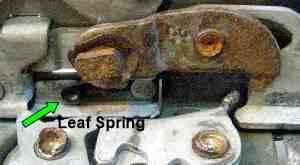
Posted on: 2017/4/22 11:43
|
|||
|
||||
|
Re: 1948 door latch
|
||||
|---|---|---|---|---|
|
Forum Ambassador
|
If a wheel is what is worn on a latch there are kits which can replace that piece. There is one on ebay now which according to the paperwork would also fit some 41-50 Packard latches. That particular kit seems to only have the wheel and cover but some other kits of a different brand which pop up from time to time on ebay have more components. Not sure what replaces the rivets as I never paid that much attention. You could probably do it with a threaded bushing or spacer and use smaller screws thru the old rivet holes into the spacer to hold it all together.
As to doing something via the pillar to release the striker plate I am not sure that is possible. The striker is fastened with several larger screws into a captured threaded plate retained in the pillar by some bent over prongs and slots. Even if you were successful in in freeing the capture plate from the retainers the screws would have to be removed completely to let the striker move more than the oversized holes in the pillar would allow. There is no way to access and unscrew them from behind and some are in there very tight so threads would in all probability be damaged trying to the point screws would become permanent. In addition, some strikers have a small sheet metal position holding screw directly into the pillar which could be challenging to remove. Another problem is with the door present there is minimal space for the extra screw length to go to clear the pillar so unless somehow the screws were sawn in half the striker would still be captured.
Posted on: 2017/4/22 13:08
|
|||
|
Howard
|
||||
|
||||
|
Re: 1948 door latch
|
||||
|---|---|---|---|---|
|
Home away from home
|
My proposal is to mark, perhaps by making a thin aluminum template, the location of the four screws that hold the striker to the forward edge of the 'B' pillar, but make this template for the expressed purpose of marking rear facing edge of the pillar. The second item would be to machine the four 12-24 screws with a lathe center, and perhaps shorten them if they are any longer than need be.
Then if a front door latch fails the possibility of drilling the striker screws is a technical possibility that could be addressed at that time. What would be required is to drill each screw to the bottom of the head, but through the Phillips head (named after businessman Henry Frank Phillips) would also be equally acceptable. Drilling of the screws would be from the back side of the 'B' pillar (rear door open). Once the screws have been weakened perhaps they will shear under the load of someone trying to push the front door open. I've taken all four screws out (one at a time) on the right side. There appears to be 'nut plates' in the interior of the pillar. I didn't see anything unusual about the design. I would consider the machining of the lathe centers to be non-destructive and completely out of sight. I looked at the eBay link, especially the last picture. I believe the table indicates at a 640-E item would fit a Packard left front latch. The auction is for a 640-A item . . . may not work 'as is'. After a bit of thinking about the operation of the latch I have drawn the conclusion that the ratchet moves CW and CCW 90 degrees always engaging the same 'tooth' into the striker. The pawl wear I observed needs a bit more investigation . . . it may be limited to only one 'valley'. Perhaps manually rotating the 'gear' ? turn will expose a surface with less wear. dp
Posted on: 2017/4/22 23:12
|
|||
|
||||
|
Re: 1948 door latch
|
||||
|---|---|---|---|---|
|
Home away from home
|
I would not recommend the repair kit that HH56 found on ebay. It would be much better to remove the the lock assb. from the door and rebuild it by replacing the wheel from the inside or finding a good used lock. I rebuild them by using wheels from the left rear door. There is a repair kit that supplies a new wheel and plate for the inside, However they are getting very hard to find for the left front door.
Posted on: 2017/4/23 11:30
|
|||
|
35-1200 touring sedan 42-110 convertible coupe 48-2293 station sedan |
||||
|
||||
|
Re: 1948 door latch
|
||||
|---|---|---|---|---|
|
Forum Ambassador
|
There is also a 640B kit on ebay which may be the opposite turn configuration. I'm with Dell on not using it as a first choice because it does not appear to be as complete a kit as the other ones I mentioned showing up from time to time. Better than an unsafe or inoperative latch though. Don't remember the mfg on the other kits but IIRC, the box is larger and more red than yellow. it may be a Mopar approved dealership item since the listings usually lead off as being for Mopar products.
Posted on: 2017/4/23 11:47
|
|||
|
Howard
|
||||
|
||||
|
Re: 1948 door latch
|
||||
|---|---|---|---|---|
|
Home away from home
|
I just got home and forgot to get a picture of the good repair kit. Will write myself a note for tomorrow. Sorry 8deluxe; I had not read all the posts and did not relies that you could not get the door open. In post 4 the arrow on the right should unlock the roller if you can push it down with some type of tool. If not I think you will have to remove the front seat and attempt to remove the window trip and door panel to get at the lock. If you would like I think I have an old lock I can send you.
Posted on: 2017/4/23 18:02
|
|||
|
35-1200 touring sedan 42-110 convertible coupe 48-2293 station sedan |
||||
|
||||

